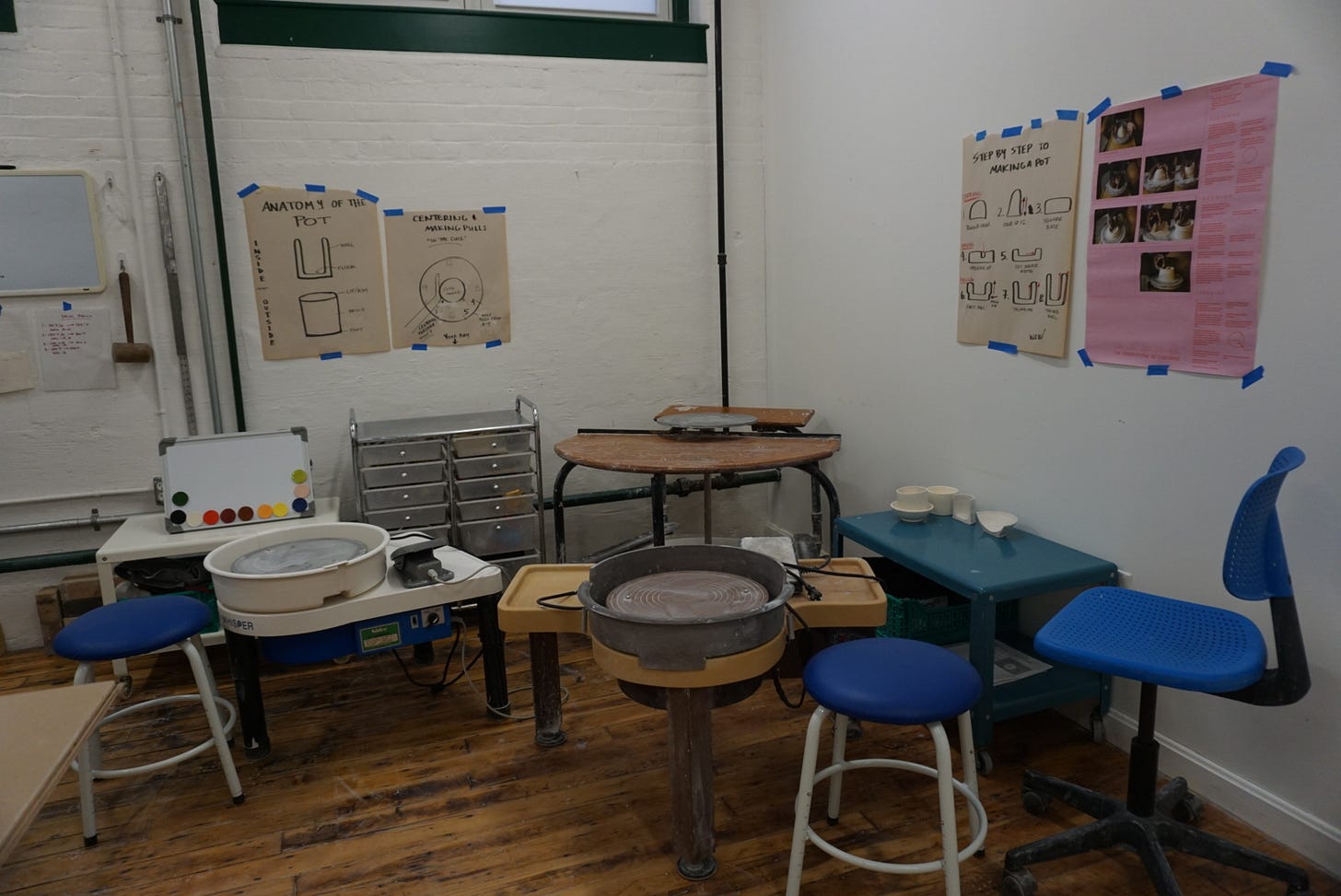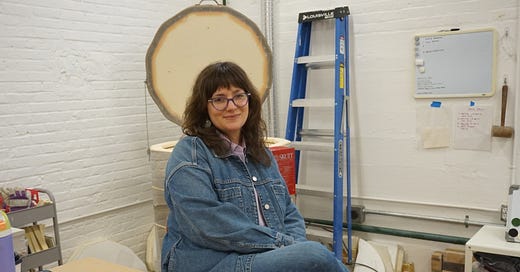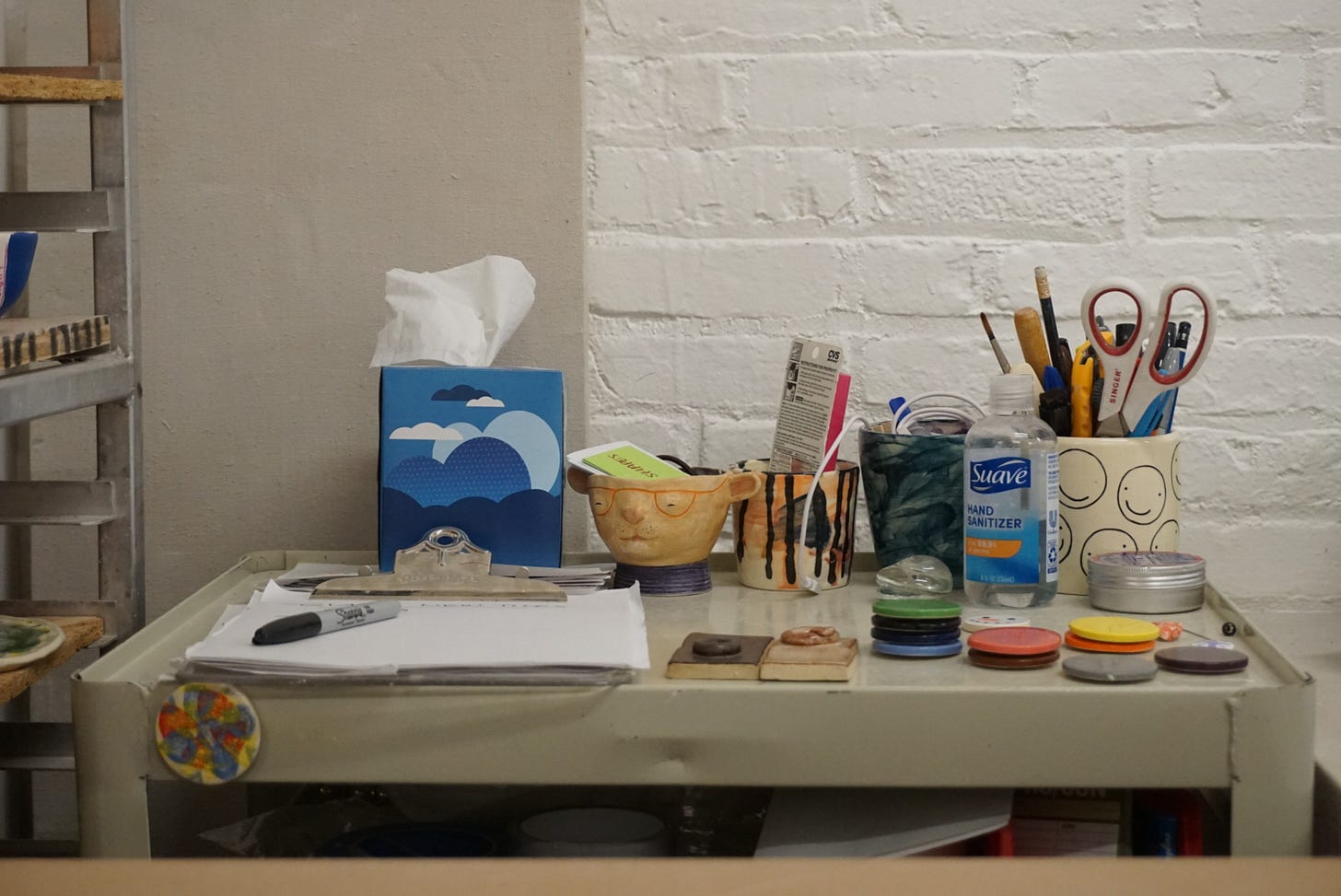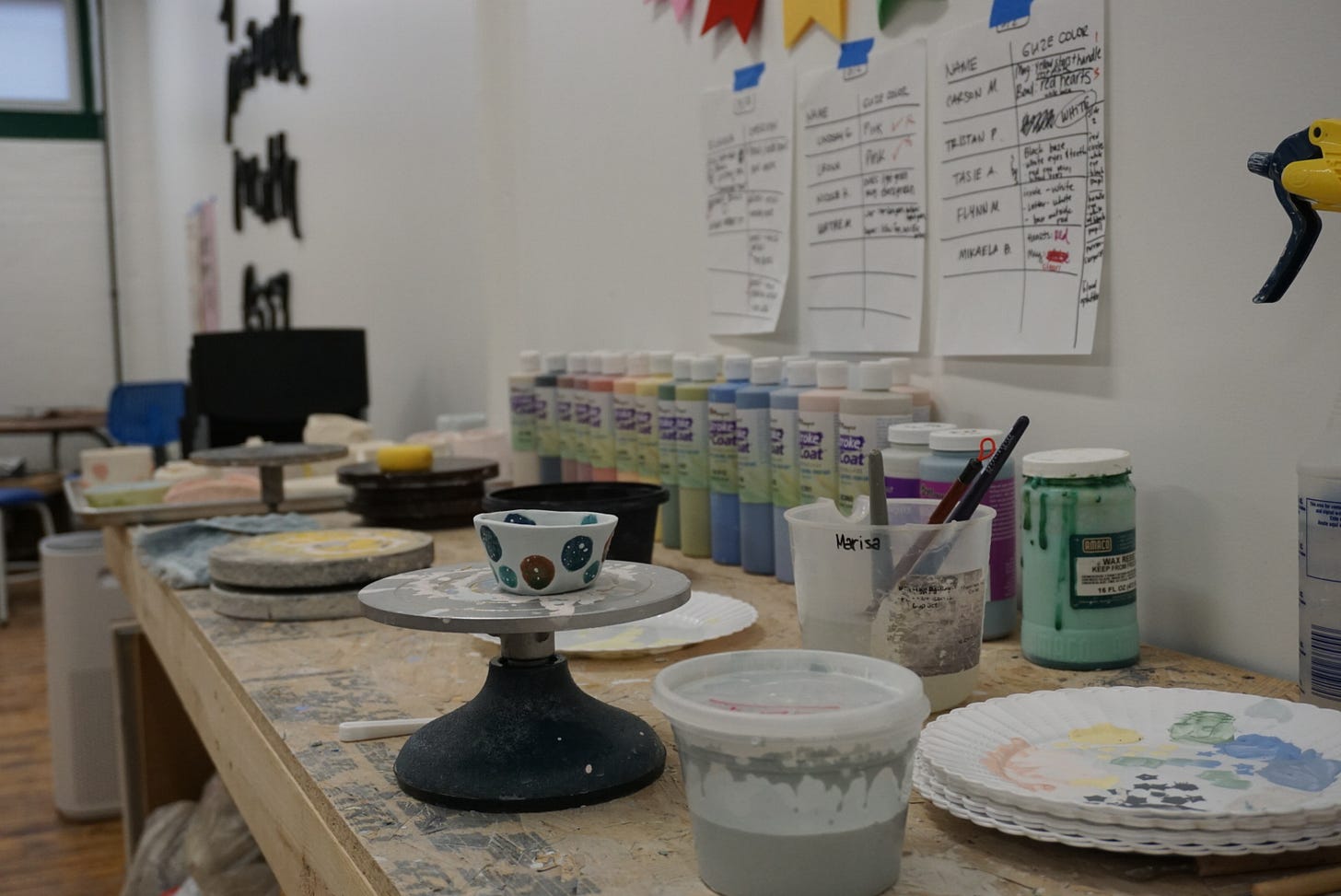Seek Alternate Route #4: Marisa Finos
In which we discuss creating as a language, seeking balance, being present while making things, and more.
If you’ve kept up with Seek Alternate Route thus far (thank you!!!), you may have noticed that it’s been a pretty music-heavy endeavor. This probably doesn’t come as a surprise—I’ve talked at length in other posts about my experiences discovering, listening to, and collecting physical copies of the music that I love. My interviews so far have also been music-centric, speaking with record store owners and musicians alike.
Even so, this blog was never meant to be just about music. My goal is to talk to individuals across creative disciplines and walks of life, learning about their experiences and gleaning their own personal lessons about creativity. And while I’ve kept a shortlist of possible interviewees, sometimes the best opportunities just fall right into your lap.
That’s exactly how this interview with local artist, studio owner, and teacher Marisa Finos came about. After hearing about Marisa’s ceramics lessons and workshops through a friend, my girlfriend and I decided to book a wheel throwing session with her earlier this spring. The time we spent at her studio was more fun and engaging than I could’ve expected, and I knew by the end of our lesson that I needed to interview Marisa soon. And here we are! I hope you enjoy.
Seek Alternate Route Talks with Marisa Finos
I met with Marisa on a chilly day at the start of April, one of the last holdouts of a winter just about ready to give way to spring. Her studio—a bright, spacious room located in one of the many repurposed mill buildings in Pawtucket, RI—can be found in the company of a variety of other creative spaces, studios, and displays of local art.
The last time I’d visited the studio for my wheel throwing lesson, it’d been set up with all of the necessary supplies—pottery wheels, clay, shaping tools, water buckets, glazes, and a whole lot of hand towels. This time, Marisa was kind enough to furnish her space for an entirely different kind of creative activity: a free-flowing conversation around her art, her teaching experiences, the practice of being creative, and a whole lot more.
On Early Experiences with Creativity and Art as Language
Seek Alternate Route: Do you remember your first experiences with being creative? Is there any sort of inciting incident or memory, whether during childhood or later, of what led you to where you are now?
Marisa Finos: I have two distinct memories. One was when I was maybe five or six—I grew up with a mom that really encouraged me to keep a journal, so I have all of these little diaries from growing up. I remember reading one a few years ago from when I was five years old, and I’d written something like “I'm gonna be an artist when I grow up.” I read that and was like, “Oh my God, I even knew back then that this was my thing?”
SAR: Yeah, you were pretty dead-on!
MF: Right? I guess my second memory is of being at a summer camp when I was in middle school, maybe fifth or sixth grade, and I got to try wheel throwing for the first time. I was immediately like, “Oh, this is my language.” I felt like my brain turned on, like I had experienced something that I had never experienced before. It was so tactile, and it brought a sensory experience to my body that I had never encountered. Immediately I knew that it was what I wanted to do.
SAR: So you dove straight into ceramics, right off the bat? Or were you trying other things—like every kid colors in their coloring book, makes little paper snowflakes, stuff like that—that carved a path towards this discipline?
MF: I was very fortunate to grow up in a household that really appreciated art, so I always had drawing utensils. And I was taught that I could express myself through art at a very young age. And I remember making, like, really intense drawings when I was a kid, when I was trying to figure out life or things that happened in my family and stuff like that.
SAR: Are there other artists in your family?
MF: Yeah my mom is an incredible writer, she's published a few things, and she’s a really amazing poet as well. And a great piano player! So she really encouraged us and pushed us to explore different avenues of creativity. My dad is one of those guys that’s an incredible photographer and painter, but he'll rarely do it.
SAR: Ok, so definitely a creative background! But you took things a step further and made your art into a lifelong pursuit, as well as a career.
MF: Yeah, I think the feeling that creating was a meaningful thing for me just kept gradually building over time. It was a language that I could use and that I was fluent in. And even if it wasn't appreciated or understood all of the time, I felt that it was the most honest representation of my thoughts and feelings when words couldn't come.

On the Process of Uncovering Creative Communities
SAR: So I can see from your various exhibitions and teaching experiences that you’ve been all over the country—Virginia, Texas, Colorado, and beyond. When you decided to come back to the northeast, what made you choose to settle here in Pawtucket?
MF: Can I be a super nerd for a second? Pawtucket is the birthplace of the American Industrial Revolution.
SAR: Wait, what? I had no idea.
MF: Yeah, there's so many mills here because they were a source of production, the waterways like the Blackstone River were powering them all. The first mill in America is right down the street! The Slater Mill.
SAR: Wait I know exactly what you’re talking about, I think I toured an apartment there at one point.
MF: It’s so interesting to be in a city that’s known for being a source of production and creation. Making things is an inherent part of being here. And I love having the studio in an old mill too, it just feels like a hive of creation.
SAR: I feel like that’s kind of a central theme of this whole area. Like they call Providence “The Creative Capital,” and you can see a lot of the public murals and local theaters, and yet it still took me a while to personally uncover the extent of the creative community here. It’s truly still very much a work in progress, stretching from when I started college here almost ten years ago until now. Back then I really only knew about the mall, the Dunk, and WaterFire—there was so much happening that I didn’t recognize or have any idea about.
MF: Yeah, it's funny too, because I think folks here are a little—I don't wanna say secretive—but they're a little more under their radar than in other places. There's so many incredible creatives here, and you wouldn’t necessarily be aware of them unless you sought them out. It's not like New York, they're here because it's more low-key. You can kind of, I don't know, hide away a little bit.
SAR: Oh totally. When I first started searching for records in the area I remember the feeling of finding what I considered to be sort of hidden gems, shops like Music Research Library that were tucked away in the corner of another old mill building and I would’ve never seen in passing. It’s kind of like what you’re describing, having to put in an effort to uncover things and form connections that might, at first, be more hidden.
MF: Yeah, you have to really give it a shot and have the patience to eventually find it or encounter it, which I think is kind of a fun thing.
SAR: Exactly! Some of it comes to you, some of it you need to discover on your own. You just need to make an effort instead of, I don’t know, sitting on a college campus for four years and assuming you know the city and community…hypothetically speaking, of course.
On Seeking Balance (if It Actually Exists)
SAR: As someone who expresses themself through art but also works in it as your profession, is there any crossover between creating for yourself and creating for work? Are you able to separate the two, or does it end up kind of all in the same pot?
MF: My gosh, this question…I think about this every day. I don't wanna say I haven't figured it out yet, but I’m also not a person that's like, “Oh yeah, my life is balanced!” I don't believe in that stuff at all; it's always gonna kind of be everything all the time, you know?
SAR: Yeah, I understand that—I write for work and for personal projects like this, and finding the energy to balance it can definitely feel like a tug-of-war.
MF: Right! I will say that when I had jobs that weren't creative, I became so sapped of all of my energy. So much so that I didn't have the life force and the energy to put into my own work. So I’d have these really weird, intense “seasons of making,” I call them. Periods where I'd work jobs during the winter and then in the spring I’d focus on making my own work. Designating specific times, kind of working and creating in cycles.
SAR: Are you in one of those cycles right now? Or has that cyclical, seasonal model changed up with your newer teaching profession? It is still pretty new, right?
MF: Yes, I recently transitioned into doing ceramics full time as a teacher, so my business is new and young. And I'm definitely still figuring out a lot of things—it's so funny because I was like, “I want to be my own boss because I’ll be able to make my own work more!” And now I'm like, oh Marisa, that’s not what it's like at all.
SAR: Is it more work than you were expecting? Or is it just difficult to strike the right kind of work/life balance?
MF: Well, I'm working more than I ever have because I'm working for myself. Since I’m wearing all the hats, it is hard to find the time to be creative on my own, doing the kind of soul work that I want to make. But at the same time, I’ve found that being in my studio more often is making me think more about the things I really want to make. So I'm getting closer, but it is hard being in it all the time. And I'm also trying to switch how I think about it in my brain, because teaching, to me, is being creative. It’s helping other people discover things, and see the light go on for them—that's part of my practice as well. Because that’s the point of art! So yeah, I really am trying to see all of it as, like, part of one whole.
On Needing to Be Present While Creating
SAR: I’ve noticed you tend to involve yourself in a lot of your projects and exhibitions, whether it’s building a 900-pound clay dome around your body or projecting images of yourself across various surfaces. It made me curious about how you view the relationship between the artist and the art they’re producing—I feel like some people make something, put it out there, and then turn it over for other people to experience. But with your work it’s kind of like you’re making it, and then you're in it, and then there's people interacting with you while you’re still creating. Do you find your art most fulfilling when you're an active part of it?
MF: The way I’ve always created, I need something alive in front of me right now. I have a hard time working on drawings or paintings because they feel a little removed from my physical life. But the way I can use clay, I’m working with it really as an extension of the human body. Clay is so weird—the physical properties of the material can take on similar qualities of the human body. When working with it in its raw form it can be very pliable and flesh-like, and then when it’s fired it becomes like bone. It also goes through a lot of the same kinds of cycles that the human body can go through. So my work is so much about exploring my own mortality through that material. Because of that, I really feel like I gotta be in it; I gotta be experiencing it so other people can imagine themselves in it and consider themselves and their mortality as well.
SAR: Yeah, I mean, this makes me think back to the lesson Emily and I did with you a month or so ago. Early on, you mentioned how important proper breathing and bodily awareness and focus were, but I didn’t fully understand it until the clay started to kind of…fight back? So I really had to lock in, and focus on breathing, and focus on how I was shaping my hands and how much pressure I was exerting. It really forced me to take an active role in what I was creating and block out any distractions. And afterwards, I was thinking of how great that was—at a time where our engagement with things like music and podcasts and audiobooks and the like can be so “hands-off,” I found myself in a situation where I had to be fully present, or else it’d come through negatively in what I was creating.
MF: Yes! I love working with clay so much because it's such a humbling material. You can work your whole life with clay, really knowing the material, and it can still rebel against you. Like no, I'm not gonna do that—I’m gonna crack and break. I’ve worked on pieces for six months before just for them to break.
SAR: NO!! Oh man, that’s terrible!
MF: I mean, you learn a lot about loss and not investing too much in certain things. So it’s like what you said about being able to be present with something that is living and changing in front of you, because your body is changing it and influencing it. It's literally recording your emotion as a maker, and the shape of your hand, your fingerprints and stuff. I just love it so much.

On The Impact of Teaching and Learning to Fail
MF: I think my favorite thing about my work is teaching clay, and I love working with people that aren't from a creative background. A lot of folks come in here and they're really good at their job—they’re a great surgeon or a lawyer or whatever, just super good in a position where they have a ton of control. Clay forces everyone to be humbled in the beginning when you’re just starting out. It takes a lot patience; you really do have to form a relationship with the material and practice doing it.
SAR: Does this teaching side of your work fulfill a different kind of creative need or desire for you? Or is it mixed in with creating and running your business? Like, does watching people learn what you're teaching them and apply those skills fill your cup in its own kind of way?
MF: Wow…I don't know. I think it's one big bucket, but maybe there's a smaller bucket inside? I feel like for me, teaching has been so important for my inner little kid. Like, I had a lot of learning differences growing up, and I had a really hard time in school. And that’s why art was an escape; I had the chance to be like, “Oh my God, I’m good at this thing when I kinda suck at everything else?” There's a reason that I’m good at it! My brain is catered to understanding what this is, or designed to get it better. So as a teacher, my mission is really to let people know that there's not one way to learn. And that it's okay to not be good at something at first, that you should be failing as you go. Failing while you're learning is important because that’s how you actually learn.
SAR: Oh for sure; if you don’t fail, you’re not going to learn how to do anything better, right?
MF: Right. And I think in school, at least like when I was young, failing was bad. It reflects on your grade, it affects your opportunities. It’s not often that we're provided with situations where we can fail with fun. Like low stakes fail, you know what I mean? In a scenario where you can also enjoy it. But yeah, I feel like that's the big bucket of it all, it’s letting folks know that it’s safe to fail here in the studio. It's safe to explore art, and not be judged, and make something weird. And that’s perfectly okay. Because that's what making is—you should just make whatever weird stuff comes out of your brain.
On Taking the Pressure Off
SAR: Is there anything you’d like to improve on creatively? Whether that’s in your own art, your professional work, teaching, or something else?
MF: Oh, I love this…make me think, put me to work. I mean, in the same vein of letting go, I think I'm a huge perfectionist. I'm a lot like, “I can't let the world see what I did unless it's completely 100%.” But if I wait for that to happen, I'm never actually gonna show it—which is the opposite of what you're trying to do with art. So yeah, I think just letting go a little bit more and not putting so much pressure on myself to make. Because I definitely have this inner monologue that’s been running in my brain since art school, saying that if you’re not making, you're not an artist…which is total bullshit!
SAR: Agreed!
MF: When I experience imposter syndrome or I’m not feeling like “enough” of an artist because I’m not creating my artwork or making a living from it, I have to remind myself that I’m living a creative life and that’s radical in itself. Anyone can channel their inner artist and live creatively. The titles are silly, right? So it’s really about working through those made up things or like voices that I've had in my life that keep me from going the full distance in my creative practice because I'm afraid to fail. Because like we said earlier, if you don't fail, then you're not learning.
Marisa’s Recommendations for Staying Creative
At the end of our conversation, I asked Marisa for her recommendations for fostering creativity. These included:
1. Be in Your Space
You have to put yourself in the kind of setting that you need to be making things in. Sometimes I'm like, “Ugh, I don't wanna make anything!” But if I go to my studio, I have to be in the space and I'm just naturally gonna be thinking about these things more. Changing your location to a space where you can access more activity or be around more creativity is really important.
2. Commune with Creatives
Being around other creative people is huge. When I first moved back here I had a hard time meeting other creatives, it was such a struggle. And you can't create in a vacuum all by yourself—it's really hard. It's important to have other people to snap you out of it, have folks that you trust who can talk about how hard it can be to create. So I started this little “art accountability group” with my friends, and we meet up once a month at a bar and talk about all the struggles we’ve had with projects we're trying to do or other creative conundrums that are blocking us from making the stuff we want to make. And my God, it's really life changing to have that support.
3. Try Things that Freak You Out
Always be open to try something new that freaks you out, something that you're not gonna be good at. I think that helps you open up weird and new pathways or ways of thinking and putting things together. One thing I really am hard on myself about is that, you know, I'm really good at ceramics and I've been doing it a long time, but because of that I can get kind of bored with it. So I need to try new stuff, whether that's creating with a new material or making something huge and weird. I just know that I have a hard time with being confined and comfortable with what I do and what I'm good at. So doing stuff that totally freaks me out is great.
4. Make Weird Stuff for Yourself
Being an artist, I do often feel like I need to make money doing this. But it’s so hard and strange to put a monetary value on what you're doing, what you're making, and with social media it gets amplified. Everyone's trying to make themselves and their work marketable, and I think that kind of kills it. It can kill your work and your ideas because it's like, ok, who are you actually doing it for? You're just doing it to be enjoyed by others? It sucks when you're not putting yourself first in your creative pursuits. So I think it’s important to step back from those pressures that, at the end of the day, are all just made up. You can just make something weird and that's good enough—you don't even have to sell it, it can just live in your studio and be weird for the sake of it.
A big thank you to Marisa—not just for being a gracious host and teacher, but for approaching this conversation with such genuine interest and excitement! Check out the Ceramics With Marisa website for more information about the studio, explore Marisa’s personal website to see more of her work, and follow along at ceramicswithmarisa for updates on her latest lessons and workshops.








Stellar read